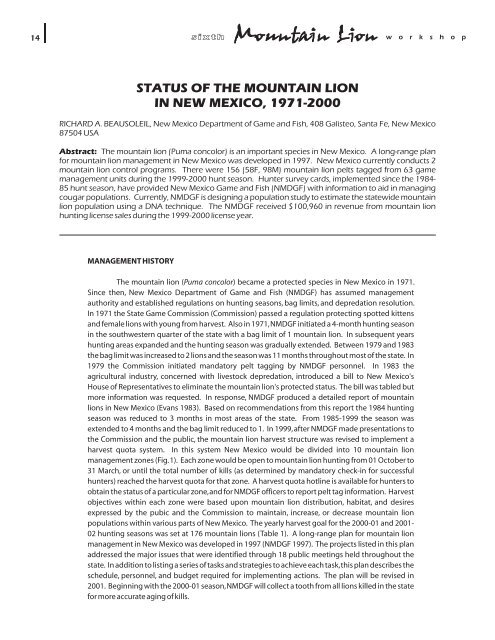PWD BK W7000-893 Proceedings.CDR - Mountain Lion Foundation
PWD BK W7000-893 Proceedings.CDR - Mountain Lion Foundation
PWD BK W7000-893 Proceedings.CDR - Mountain Lion Foundation
Create successful ePaper yourself
Turn your PDF publications into a flip-book with our unique Google optimized e-Paper software.
14<br />
STATUS OF THE MOUNTAIN LION<br />
IN NEW MEXICO, 1971-2000<br />
RICHARD A. BEAUSOLEIL, New Mexico Department of Game and Fish, 408 Galisteo, Santa Fe, New Mexico<br />
87504 USA<br />
Abstract: The mountain lion (Puma concolor) is an important species in New Mexico. A long-range plan<br />
for mountain lion management in New Mexico was developed in 1997. New Mexico currently conducts 2<br />
mountain lion control programs. There were 156 (58F, 98M) mountain lion pelts tagged from 63 game<br />
management units during the 1999-2000 hunt season. Hunter survey cards, implemented since the 1984-<br />
85 hunt season, have provided New Mexico Game and Fish (NMDGF) with information to aid in managing<br />
cougar populations. Currently, NMDGF is designing a population study to estimate the statewide mountain<br />
lion population using a DNA technique. The NMDGF received $100,960 in revenue from mountain lion<br />
hunting license sales during the 1999-2000 license year.<br />
MANAGEMENT HISTORY<br />
sixth <strong>Mountain</strong> <strong>Lion</strong> w o r k s h o p<br />
The mountain lion ( Puma concolor)<br />
became a protected species in New Mexico in 1971.<br />
Since then, New Mexico Department of Game and Fish (NMDGF) has assumed management<br />
authority and established regulations on hunting seasons, bag limits, and depredation resolution.<br />
In 1971 the State Game Commission (Commission) passed a regulation protecting spotted kittens<br />
and female lions with young from harvest. Also in 1971,NMDGF initiated a 4-month hunting season<br />
in the southwestern quarter of the state with a bag limit of 1 mountain lion. In subsequent years<br />
hunting areas expanded and the hunting season was gradually extended. Between 1979 and 1983<br />
the bag limit was increased to 2 lions and the season was 11 months throughout most of the state. In<br />
1979 the Commission initiated mandatory pelt tagging by NMDGF personnel. In 1983 the<br />
agricultural industry, concerned with livestock depredation, introduced a bill to New Mexico's<br />
House of Representatives to eliminate the mountain lion's protected status. The bill was tabled but<br />
more information was requested. In response, NMDGF produced a detailed report of mountain<br />
lions in New Mexico (Evans 1983). Based on recommendations from this report the 1984 hunting<br />
season was reduced to 3 months in most areas of the state. From 1985-1999 the season was<br />
extended to 4 months and the bag limit reduced to 1. In 1999,after NMDGF made presentations to<br />
the Commission and the public, the mountain lion harvest structure was revised to implement a<br />
harvest quota system. In this system New Mexico would be divided into 10 mountain lion<br />
management zones (Fig.1). Each zone would be open to mountain lion hunting from 01 October to<br />
31 March, or until the total number of kills (as determined by mandatory check-in for successful<br />
hunters) reached the harvest quota for that zone. A harvest quota hotline is available for hunters to<br />
obtain the status of a particular zone,and for NMDGF officers to report pelt tag information. Harvest<br />
objectives within each zone were based upon mountain lion distribution, habitat, and desires<br />
expressed by the pubic and the Commission to maintain, increase, or decrease mountain lion<br />
populations within various parts of New Mexico. The yearly harvest goal for the 2000-01 and 2001-<br />
02 hunting seasons was set at 176 mountain lions (Table 1). A long-range plan for mountain lion<br />
management in New Mexico was developed in 1997 (NMDGF 1997). The projects listed in this plan<br />
addressed the major issues that were identified through 18 public meetings held throughout the<br />
state. In addition to listing a series of tasks and strategies to achieve each task,this plan describes the<br />
schedule, personnel, and budget required for implementing actions. The plan will be revised in<br />
2001. Beginning with the 2000-01 season,NMDGF will collect a tooth from all lions killed in the state<br />
for more accurate aging of kills.
















